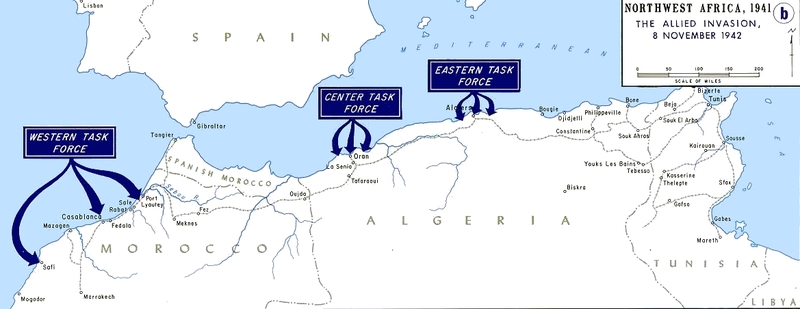The invasion of French North Africa, also known as “Operation Torch”, occurred from November 8-16, 1942. Allied forces aimed to help relieve pressure put on the Soviet Union by the Axis forces, who had invaded the country in 1941. The invasion of North Africa was also intended to help the Allied forces in Egypt gain a better foothold in the region. Finally, the operation aimed to create a pathway for the Allies to invade Europe from the south. The area in Africa the Allies intended to invade was dominated by the Vichy French. The Vichy, under the Franco-German Armistice of 1940, were given sovereignty over the southern portion of France and parts of North Africa which were not under direct German military occupation. Although the government established by the Vichy regime was proclaimed to be sovereign, they were in close collaboration with the Germans. However, intel collected by the British indicated that the Vichy occupying North Africa would not oppose an Allied invasion. General Dwight D. Eisenhower was given command of the operation, planning a three-part attack from the west in Casablanca, Morocco, the center in Oran, Algeria, and the east in Algiers, also located in Algeria.
On the night of November 8, the Allied fleet moved towards the North African coast entirely undetected, with 350 war ships, 500 transports, and 107,000 troops. The task forces assembled at their respective ports in Casablanca, Oran, and Algiers. The assault began in the morning, wherethe Allies were immediately met by opposition from the Vichy forces commanded by Marshall Philippe Pétain. The Vichy had 125,000 troops across Morocco, Tunisia, and Algeria, along with a formidable force of aircraft, artillery, and warships. This was in direct opposition to the initial intel which indicated that the Vichy would not put up much resistance. Vichy forces would indeed inflict heavy losses during the Western Task Force’s landing attempt. French snipers and machine gunners fired on the relatively unprotected troops as they landed, inflicting more casualties than expected. Despite this, the Allies would eventually be successful. On November 10, as the Western Task Force began to move toward Casablanca for an all-out attack, the Vichy surrendered. The Center Task Force experienced the same resistance as the Western Task Force, although they were able to force a Vichy surrender of Oran on November 9. Finally, the Eastern Task Force was aided by a resistance force of French who opposed the pro-German Vichy. This resistance force initiated a successful coup in Algiers that overthrew the Vichy rule and ended any resistance towards the Allies. Allied troops successfully took Algiers on November 9, convincing the Vichy High Commissioner of North Africa to order Vichy forces to stop resisting the Allies on November 11.
The invasion of North Africa was successful for the Allies, garnering significance for being one of the first times the Allied forces had taken the offensive. It also put additional pressure on the Axis forces, as they began to experience opposition on their eastern and western flanks. In addition,, the Allies gained a stronger strategic position as a result of the successful invasion. The operation was not without its drawbacks, however. The Vichy High Commissioner who ordered resistance towards the Allies to cease was temporarily allowed to head the administration of French forces who joined the Allies in North Africa. This was seen as a slap in the face to the Free French, the exiled French government who continued to fight with the Allies after France had fallen, and their leader Charles de Gaulle as the Free French distrusted the Vichy for their cooperation with Germany and their authoritarianism. The operation also failed to draw away as many German troops from the Eastern front as previously hoped. Operation Torch was the beginning of the North African campaign of WWII, opening a new front in the war. Fighting in North Africa would continue as German forces would be sent to the region to challenge the Allies. Eventually, the Allies would be successful in the North African campaign, when Axis forces surrendered there on May 13, 1943.
Suggested Reading:
Naval History and Heritage Command: Operation Torch
Norman Gelb, Desperate Venture: The Story of Operation Torch, The Allied Invasion of North Africa (William Morrow and Company, 1992)
Orr Kelly, Meeting the Fox: The Allied Invasion of Africa, from Operation Torch to Kasserine Pass to Victory in Tunisia (Wiley, 2002)








